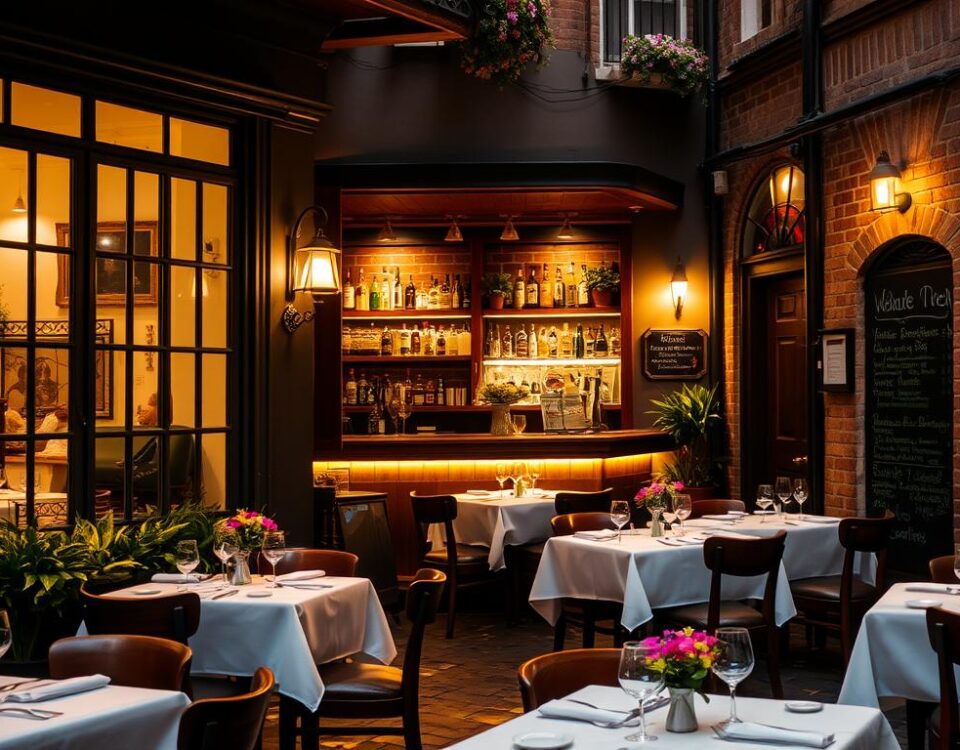
The Best Commercial Blenders for Restaurants Tested and Ranked
July 1, 2025
6 Knife Care Secrets Every Pro Chef Swears By
July 2, 2025As a seasoned catering professional, I’ve encountered my fair share of challenges when it comes to maintaining the perfect temperature for hot food during events. I recall a particularly demanding wedding reception where I had to keep food warm for over three hours without compromising its quality.
According to research by IMARC Group, the food warming equipment industry is predicted to reach $900m by 2032, underscoring the importance of effective solutions for catering businesses. Did you know that serving food at the wrong temperature can lead to a significant decrease in customer satisfaction?
Maintaining the ideal temperature is crucial not only for food safety but also for ensuring that your guests enjoy the best possible dining experience. So, how can you achieve this delicate balance between heat and moisture?
Key Takeaways
- Professional techniques to maintain food temperature while preserving moisture and flavor.
- The importance of proper temperature management for catering events.
- Simple DIY solutions using items like aluminum containers to keep food warm.
- Practical methods to balance food safety requirements with quality preservation.
- Effective strategies for maintaining the ideal temperature during large events.
The Importance of Proper Food Temperature Management
When it comes to catering, managing food temperature is not just about keeping food hot or cold, it’s about ensuring food safety and quality. Proper temperature control is critical to preventing bacterial growth and maintaining the moisture content of the food.
Understanding the Food Temperature Danger Zone
The FDA defines the “danger zone” as temperatures between 41°F and 135°F, where disease-causing bacteria can rapidly multiply. To prevent foodborne illness, hot foods should be kept at 135°F or above, while cold foods should be maintained at 41°F or below. Understanding this critical temperature range is essential for both food safety and quality.
| Temperature Range | Food Safety Status |
|---|---|
| Below 41°F | Safe (Cold Food) |
| 41°F – 135°F | Danger Zone |
| Above 135°F | Safe (Hot Food) |
Why Food Dries Out When Kept Warm
Food dries out when kept warm primarily because of moisture evaporation, which accelerates at higher temperatures without proper humidity control. Different food types have varying moisture content and therefore require different approaches to temperature maintenance. For instance, proteins coagulate and moisture escapes when food is kept at high temperatures for extended periods without proper techniques.
Professional caterers must balance the competing needs of food safety with food quality. Proper temperature management is not just a matter of taste but also about protecting your guests’ health. By understanding the science behind bacterial growth and moisture evaporation, caterers can take appropriate measures to maintain the quality and safety of the food.
Essential Equipment to Keep Catering Food Hot
To keep food at the optimal temperature during catering events, it’s essential to invest in the right warming equipment. The right tools not only ensure that your food remains hot and fresh but also make the serving process more efficient.
Chafing Dishes and Fuel Sources
Chafing dishes are a staple in catering, providing a water bath system that gently heats food while maintaining humidity. This prevents food from drying out. Fuel sources like Sterno Chafing Fuel Can With Stem Wick can last up to six hours, making them ideal for large events.
Insulated Food Containers and Carriers
Insulated containers, such as Round Aluminum To-Go Containers, feature self-sealing rims and reflective surfaces that help maintain the internal temperature. These containers are crucial for transporting hot food to event locations.
Steam Tables and Warming Trays
Steam tables and warming trays offer excellent temperature control for buffet-style service. They come with options for both wet and dry heat applications, making them versatile for different types of cuisine.
Aluminum Foil and Heat-Retaining Materials
Aluminum foil and other heat-retaining materials play a supporting role in maintaining food temperature. Techniques such as wrapping food in aluminum foil help redirect heat back to the food, keeping it warm for longer.
By investing in the right equipment, caterers can ensure that their food remains hot, fresh, and of high quality throughout the event. Whether it’s chafing dishes, insulated containers, steam tables, or aluminum foil, each piece of equipment has its unique benefits and applications.
Professional Methods to Keep Catering Food Hot Without Drying Out
I’ve found that using the right techniques can make all the difference in keeping catering food hot and fresh. As a caterer, maintaining the perfect balance of heat and moisture is crucial for serving high-quality dishes.
Using Water Baths and Steam
One effective method is using water baths and steam to create a humid environment that prevents moisture loss. This technique is particularly useful for delicate foods like sauces and soups. To set up a water bath, fill a large container with hot water to a level that’s about halfway up the side of the dish containing the food. Then, place the food dish into the water bath, making sure not to overflow. Maintain the water temperature between 145°F and 155°F to keep the food warm without overcooking it.

Proper Covering Techniques
Proper covering techniques are essential for retaining heat and moisture. Different foods require different covering methods. For instance, using a lid or aluminum foil can effectively trap heat, while plastic wrap can help manage condensation. When covering food, make sure to leave a small vent for steam to escape, preventing the buildup of excessive moisture that can lead to sogginess.
| Food Type | Covering Method | Benefits |
|---|---|---|
| Sauces and Soups | Lid or Plastic Wrap | Retains moisture, prevents drying out |
| Meats and Vegetables | Aluminum Foil | Trap heat, easy to manage |
Temperature Monitoring Best Practices
Monitoring temperature is critical for food safety and quality. I recommend using reliable thermometers to check the temperature of the food regularly. It’s essential to establish a monitoring schedule to ensure that the food remains within a safe temperature range. Check the temperature every 30 minutes to adjust the heating source as needed.
Rotating Food Items Strategically
Rotating food items is a simple yet effective way to ensure even heating. By periodically rearranging the food, you can prevent some portions from drying out while others remain moist. Develop a systematic approach to food rotation based on serving patterns and food types to maintain consistent quality throughout your event.
Food-Specific Strategies to Maintain Heat and Moisture
Maintaining the perfect temperature and moisture levels for various types of food is crucial for a successful catering event. Different foods have unique requirements to stay warm and fresh. I’ll outline specific strategies for meats, pasta and rice dishes, vegetables, and sauces to help you keep your catering food at its best.
Keeping Meats Juicy and Hot
To keep meats juicy, it’s essential to use proper resting and tenting techniques. For instance, tenting a roast or steak with aluminum foil while it rests helps maintain a warm temperature and allows juices to redistribute. This method is particularly effective for large cuts of meat.
Maintaining Pasta and Rice Dishes
Pasta and rice dishes can become gummy when held at temperature. To prevent this, adding a small amount of oil or butter creates a protective barrier that maintains texture. Using a rice cooker on the “warm” setting can also keep rice hot and moist for over an hour.
Preserving Heat in Vegetables and Sides
Vegetables present unique challenges, with some varieties maintaining heat better than others. Delicate greens require gentle heat, while hearty root vegetables can withstand higher temperatures. Using insulated containers can help maintain the optimal temperature for various vegetable types.
Sauces and Gravies: Preventing Skin Formation
Sauces and gravies can develop unappetizing skin when held at temperature. To prevent this, stir the sauces regularly and cover them with plastic wrap or wax paper, ensuring the wrap touches the surface of the sauce to prevent air contact.
| Food Type | Recommended Method | Equipment |
|---|---|---|
| Meats | Tenting with aluminum foil | Aluminum foil, warming trays |
| Pasta and Rice | Adding oil or butter | Rice cooker, insulated containers |
| Vegetables | Gentle heating | Insulated containers, steam tables |
| Sauces and Gravies | Regular stirring, covering | Sauce warmers, plastic wrap |
Troubleshooting Common Hot Food Holding Problems
Effective troubleshooting strategies are essential for caterers to manage hot food holding issues. When unexpected challenges arise, having the right solutions can make all the difference in maintaining food quality.
Dealing with Limited Power Sources
Limited power sources at event venues can severely restrict heating options. To overcome this, consider using fuel-based heating systems or insulated containers that don’t rely on electricity. Strategic food preparation timing can also help maintain the desired temperature. For instance, heating the plates before serving can be a simple yet effective solution.
Managing Food During Transportation
Transporting hot food requires careful planning to maintain its temperature. Using coolers or insulated shopping bags can help keep food hot. If the food isn’t in a covered dish, transfer it to a covered container or wrap it in aluminum foil before storing it in the cooler or bag. This ensures that the food stays hot for a longer period.

Conclusion
To keep food hot and fresh, it’s essential to strike a balance between food safety and quality preservation. By implementing the strategies outlined, such as using chafing dishes and steam tables, you’ll be able to maintain the perfect temperature for your catering food.
Effective temperature monitoring and the right equipment can make all the difference. Whether you’re managing a large event or a small gathering, keeping food warm without drying it out is achievable with the right techniques.
By mastering these skills, you’ll enhance the dining experience, ensuring your guests enjoy hot foods that are both delicious and safe to eat.
FAQ
What is the best way to maintain the temperature of my dishes during a long event?
I recommend using a combination of chafing dishes with fuel sources, such as sterno or electric warming trays, and insulated containers to maintain a consistent temperature. This will help keep my dishes warm without drying them out.
How can I prevent my meats from becoming dry when keeping them warm for an extended period?
To keep meats juicy, I suggest using a water bath or steam to maintain moisture. Additionally, covering the meat with aluminum foil or a heat-retaining material can help retain its natural juices.
What are some strategies for keeping pasta and rice dishes warm without becoming mushy or dry?
For pasta and rice dishes, I find that using a steam table or warming tray with a lid helps maintain the right temperature and moisture level. I also make sure to stir the dishes periodically to prevent them from becoming sticky or clumpy.
How can I prevent sauces and gravies from forming a skin when kept warm?
To prevent skin formation, I recommend stirring the sauces and gravies frequently and covering them with plastic wrap or aluminum foil, making sure to press the wrap directly onto the surface to prevent air from reaching it.
What should I do if I have limited power sources available for my warming equipment?
In situations with limited power, I use insulated containers or thermally insulated bags to maintain the temperature of my dishes. I also prioritize the dishes that need to be kept warm the most and allocate my power sources accordingly.
How can I manage my dishes during transportation to ensure they stay warm?
To transport dishes while keeping them warm, I use insulated carriers or thermally insulated bags with heat packs or warming trays. I also make sure to pack the dishes tightly and securely to prevent them from shifting during transport.



